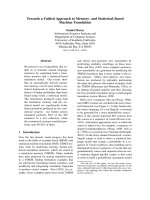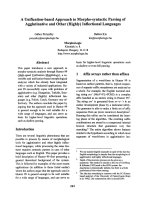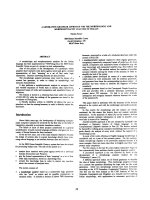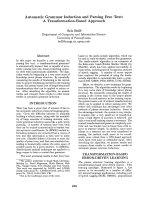Self-Assembly and Nanotechnology: A Force Balance Approach
Bạn đang xem bản rút gọn của tài liệu. Xem và tải ngay bản đầy đủ của tài liệu tại đây (1.85 MB, 361 trang )
SELF-ASSEMBLY AND
NANOTECHNOLOGY
SELF-ASSEMBLY AND
NANOTECHNOLOGY
A Force Balance
Approach
Yoon S. Lee
Scientific Information Analyst
Chemical Abstracts Service
A Division of the American Chemical Society
Columbus, Ohio
A JOHN WILEY & SONS, INC., PUBLICATION
Copyright © 2008 by John Wiley & Sons, Inc. All rights reserved.
Published by John Wiley & Sons, Inc., Hoboken, New Jersey.
Published simultaneously in Canada.
No part of this publication may be reproduced, stored in a retrieval system,
or transmitted in any form or by any means, electronic, mechanical, photocopying, recording,
scanning, or otherwise, except as permitted under Section 107 or 108 of the 1976 United States
Copyright Act, without either the prior written permission of the Publisher, or authorization
through payment of the appropriate per-copy fee to the Copyright Clearance Center, Inc.,
222 Rosewood Drive, Danvers, MA 01923, (978) 750-8400, fax (978) 750-4470, or on the web at
www.copyright.com. Requests to the Publisher for permission should be addressed to the
Permissions Department, John Wiley & Sons, Inc., 111 River Street, Hoboken, NJ 07030,
(201) 748-6011, fax (201) 748-6008, or online at />Limit of Liability/Disclaimer of Warranty: While the publisher and author have used their best
efforts in preparing this book, they make no representations or warranties with respect to the
accuracy or completeness of the contents of this book and specifically disclaim any implied
warranties of merchantability or fitness for a particular purpose. No warranty may be created or
extended by sales representatives or written sales materials. The advice and strategies contained
herein may not be suitable for your situation. You should consult with a professional where
appropriate. Neither the publisher nor author shall be liable for any loss of profit or any other
commercial damages, including but not limited to special, incidental, consequential, or other
damages.
For general information on our other products and services or for technical support, please contact
our Customer Care Department within the United States at (800) 762-2974, outside the United
States at (317) 527-3993 or fax (317) 572-4002.
Wiley also publishes its books in a variety of electronic formats. Some content that appears in
print may not be available in electronic formats. For more information about Wiley products, visit
our web site at www.wiley.com.
Library of Congress Cataloging-in-Publication Data:
Lee, Yoon Seob.
Self-assembly and nanotechnology : a force balance approach / Yoon Seob Lee.
p. cm.
Includes index.
ISBN 978-0-470-24883-6 (cloth)
1. Nanostructured materials–Design. 2. Nanotechnology. 3. Self-assembly
(Chemistry) I. Title.
TA418. 9. N35L44 2008
620′.5—dc22
2007052383
Printed in the United States of America.
10
9
8
7
6
5
4
3
2
1
To my mother
CONTENTS
Preface and Acknowledgments
PART I. SELF-ASSEMBLY
1.
xv
1
UNIFIED APPROACH TO SELF-ASSEMBLY
1.1. Self-Assembly through Force Balance
1.2. General Scheme for the Formation of Self-Assembled
Aggregates
1.3. General Scheme for Self-Assembly Process
1.4. Concluding Remarks
References
3
5
8
10
17
18
2.
INTERMOLECULAR AND COLLOIDAL FORCES
2.1. Van der Waals Force
2.2. Electrostatic Force: Electric Double-Layer
2.3. Steric and Depletion Forces
2.4. Solvation and Hydration Forces
2.4.1. Solvation Force
2.4.2. Hydration Force
2.5. Hydrophobic Effect
2.6. Hydrogen Bond
References
21
22
28
33
37
37
38
39
42
44
3.
MOLECULAR SELF-ASSEMBLY IN SOLUTION I: MICELLES
3.1. Surfactants and Micelles
3.2. Physical Properties of Micelles
3.2.1. Micellization
3.2.2. Critical Micellar Concentration and Aggregation
Number
3.2.3. Counterion Binding
47
48
50
50
51
53
vii
viii
CONTENTS
3.3. Thermodynamics of Micellization
3.3.1. Mass-Action Model
3.3.2. Pseudo-phase Separation Model
3.3.3. Hydrophobic Effect and Enthalpy–Entropy
Compensation
3.4. Micellization versus General Scheme of Self-Assembly
3.4.1. Change of Micelle Structures
3.4.2. General Scheme of Micellization
3.4.3. Concept of Force Balance and Surfactant Packing
Parameter
3.5. Multicomponent Micelles
3.6. Micellar Solubilization
3.7. Applications of Surfactants and Micelles
3.7.1. Micellar Catalysis
References
4.
5.
53
54
55
57
58
58
60
60
63
66
68
69
71
MOLECULAR SELF-ASSEMBLY IN SOLUTION II: BILAYERS,
LIQUID CRYSTALS, AND EMULSIONS
4.1. Bilayers
4.1.1. Bilayer-Forming Surfactants
4.1.2. Bilayerization
4.1.3. Physical Properties of Bilayers
4.2. Vesicles, Liposomes, and Niosomes
4.2.1. Physical Properties of Vesicles
4.2.2. Micellar Catalysis on Vesicles
4.3. Liquid Crystals
4.3.1. Thermotropic Liquid Crystals
4.3.2. Lyotropic Liquid Crystals
4.3.2.1. Concentration-Temperature Phase Diagram
4.3.2.2. Ternary Surfactant–Water–Oil (or
Co-surfactant) Phase Diagram
4.4. Emulsions
4.4.1. Microemulsions
4.4.2. Reverse Micelles
4.4.3. Macroemulsions
4.4.4. Micellar Catalysis on Microemulsions
References
90
92
93
95
97
99
100
COLLOIDAL SELF-ASSEMBLY
5.1. Forces Induced by Colloidal Phenomena
5.1.1. Surface Tension and Capillarity
5.1.2. Contact Angle and Wetting
103
104
105
108
75
76
76
77
79
80
80
82
83
84
87
87
CONTENTS
6.
7.
ix
5.1.3. Adhesion
5.1.4. Gravity and Diffusion
5.1.5. Pressures by Osmotic and Donnan Effects
5.1.6. Electrokinetic Force
5.1.7. Magnetophoretic Force
5.1.8. Force by Flow
5.2. Force Balance for Colloidal Self-Assembly
5.3. General Scheme for Colloidal Self-Assembly
5.4. Micelle-like Colloidal Self-Assembly: Packing Geometry
5.5. Summary
References
109
110
112
114
116
117
118
120
121
122
123
SELF-ASSEMBLY AT INTERFACES
6.1. General Scheme for Interfacial Self-Assembly
6.1.1. Surfaces and Interfaces
6.1.2. Force Balance with Interfaces
6.2. Control of Intermolecular Forces at Interfaces
6.2.1. Packing Geometry: Balance with Attractive and
Repulsive Forces
6.2.2. Packing with Functional Groups: Balance with
Directional Force
6.2.2.1. Building Units with Multifunctional Sites
6.2.2.2. Building Units with Single Functional Sites
6.2.3. Packing of Nonamphiphilic Building Units
6.3. Self-Assembly at the Gas–Liquid Interface
6.3.1. Langmuir Monolayer
6.3.2. Surface Micelles
6.4. Self-Assembly at the Liquid–Solid Interface
6.5. Self-Assembly at the Liquid–Liquid Interface
6.6. Self-Assembly at the Gas–Solid Interface
6.7. Interface-Induced Chiral Self-Assembly
References
125
126
126
127
129
BIO-MIMETIC SELF-ASSEMBLY
7.1. General Picture of Bio-mimetic Self-Assembly
7.2. Force Balance Scheme for Bio-mimetic Self-Assembly
7.3. Origin of Morphological Chirality and Diversity
7.3.1. Chirality of Building Units
7.3.2. Asymmetric Structure of Building Units
7.3.3. Multiple Hydrogen Bonds
7.3.4. Cooperative Balance of Geometry and Bonding
7.3.5. Induced Asymmetric Packing
149
150
153
155
155
157
158
159
160
129
130
130
132
134
135
135
138
139
140
140
142
145
x
CONTENTS
7.4. Symmetric Bio-mimetic Self-Assembled Aggregates
7.4.1. H- and J-Aggregates
7.4.2. Molecular Capsules
7.5. Gels: Networked Bio-mimetic Self-Assembled Aggregates
7.6. Properties of Bio-mimetic Self-Assembled Aggregates
7.6.1. Directionality, Site-Specificity, and Chirality
7.6.2. Hierarchicality
7.6.3. Complementarity
7.6.4. Chiroptical Properties
7.7. Future Issues
References
PART II. NANOTECHNOLOGY
8.
9.
161
161
163
163
165
165
166
167
167
168
168
171
IMPLICATIONS OF SELF-ASSEMBLY FOR NANOTECHNOLOGY
8.1. General Concepts and Approach to Nanotechnology
8.2. Self-Assembly and Nanotechnology Share the Same Building
Units
8.3. Self-Assembly and Nanotechnology Are Governed by
the Same Forces
8.4. Self-Assembly versus Manipulation for the Construction of
Nanostructures
8.5. Self-Aggregates and Nanotechnology Share the Same
General Assembly Principles
8.6. Concluding Remarks
References
173
173
NANOSTRUCTURED MATERIALS
9.1. What Are Nanostructured Materials?
9.2. Intermolecular Forces During the Formation of
Nanostructured Materials
9.3. Sol–Gel Chemistry
9.4. General Self-Assembly Schemes for the Formation of
Nanostructured Materials
9.5. Micro-, Meso-, and Macroporous Materials
9.6. Mesostructured and Mesoporous Materials
9.6.1. Formation of Mesoporous Silica with Hexagonal
Structure
9.6.2. Structural Control of Mesostructured and Mesoporous
Materials
183
184
176
177
177
178
180
181
185
187
189
190
192
193
195
CONTENTS
10.
xi
9.6.3. Epitaxial Analysis at the Micelle–Silica Interface
9.6.4. Charge Matching at the Micelle–Silica Interface
9.6.5. Characterization of Mesostructured and Mesoporous
Materials
9.7. Organic–Inorganic Hybrid Mesostructured and Mesoporous
Materials
9.8. Microporous and Macroporous Materials
9.8.1. Co-Self-Assembly for the Formation of Microporous
Materials
9.8.2. Emulsions for the Formation of Macroporous
Materials
9.8.3. Colloidal Self-Assembly for the Formation of
Macroporous Materials
9.9. Applications of Nanostructured and Nanoporous Materials
9.10. Summary and Future Issues
References
198
203
NANOPARTICLES: METALS, SEMICONDUCTORS, AND OXIDES
10.1. What are Nanoparticles?
10.2. Intermolecular Forces During the Synthesis of Nanoparticles
10.3. Synthesis of Nanoparticles
10.3.1. Direct Synthesis: Confinement-by-Adsorption
10.3.2. Synthesis within Preformed Nanospace
10.3.2.1. Surfactant Self-Assembled Aggregates
10.3.2.2. Bio-mimetic Self-Assembled Aggregates
10.3.2.3. Dendritic Polymers
10.3.2.4. Nanoporous Solids
10.3.2.5. Directed Growth by Soft Epitaxy
10.3.2.6. Directed Growth by Hard Epitaxy
10.3.3. Nanoparticle Synthesis with Nonconventional Media
10.3.3.1. Supercritical Fluids
10.3.3.2. Ionic Liquids
10.4. Properties of Nanoparticles
10.4.1. Quantum Size Effect
10.4.1.1. Optical Properties of Semiconductors
10.4.1.2. Optical Properties of Noble Metals
10.4.1.3. Electromagnetic Properties of Noble Metals
10.4.1.4. Electric Properties of Metals
10.4.2. Surface Atom Effect
10.5. Applications of Nanoparticles
10.5.1. Chemical and Biological Sensors
10.5.2. Optical Sensors
10.5.3. Nanocomposites and Hybrid Materials
221
222
224
226
227
229
230
232
233
233
234
234
236
236
237
238
238
238
240
240
241
241
243
243
244
245
204
205
206
207
209
210
211
214
216
xii
CONTENTS
10.5.4. Catalysis
10.5.5. Functional Fluids
10.6. Summary and Future Issues
References
245
245
246
247
11.
NANOSTRUCTURED FILMS
11.1. What Is Nanostructured Film?
11.2. General Scheme for Nanostructured Films
11.3. Preparation and Structural Control of Nanostructured Films
11.3.1. Self-Assembled Monolayer (SAM)
11.3.2. Layer-by-Layer Assembly
11.3.3. Vapor-Deposited Films
11.3.4. Sol–Gel Processed Films
11.3.5. Langmuir-Blodgett (LB) Films
11.4. Properties and Applications of Nanostructured Films
11.4.1. Nanoporous Films
11.4.2. Nanolayered Films
11.4.3. Nanopatterned Films
11.4.4. Monolayer: Model Membrane
11.5. Summary and Future Issues
References
249
249
251
252
252
255
256
258
259
263
263
263
264
265
266
267
12.
NANOASSEMBLY BY EXTERNAL FORCES
12.1. Force Balance and the General Scheme of Self-Assembly
Under External Forces
12.2. Colloidal Self-Assembly Under External Forces
12.2.1. Capillary Force
12.2.2. Electric Force
12.2.3. Magnetic Force
12.2.4. Flow
12.2.5. Mechanical Force
12.2.6. Force by Spatial Confinement
12.2.7. Other Forces
12.2.7.1. Laser-Optical Force
12.2.7.2. Ultrasound
12.2.7.3. Gravity and Centrifugal Forces
12.3. Molecular Self-Assembly Under External Forces
12.3.1. Flow
12.3.2. Magnetic Field
12.3.3. Concentration Gradient
12.3.4. Confinement
12.3.5. Gravity and Centrifugal Forces
271
272
273
273
275
277
278
279
280
282
282
282
282
283
283
285
285
286
287
CONTENTS
xiii
12.4. Applications of Colloidal Aggregates
12.4.1. Optical Band Gap
12.4.2. Nanostructured Materials
12.5. Summary and Future Issues
References
287
287
288
288
290
13.
NANOFABRICATION
13.1. Self-Assembly and Nanofabrication
13.2. Unit Fabrications
13.2.1. Jointing
13.2.2. Crossing and Curving
13.2.3. Alignment and Stacking
13.2.4. Reconstruction, Deposition, and Coating
13.2.5. Symmetry Breaking
13.2.6. Templating and Masking
13.2.7. Hybridization
13.3. Nanointegrated Systems
13.4. Summary and Future Issues
References
293
294
296
296
297
298
299
300
302
303
304
308
308
14.
NANODEVICES AND NANOMACHINES
14.1. General Scheme of Nanodevices
14.2. Nanocomponents: Building Units for Nanodevices
14.2.1. Interlocked and Interwinded Molecules
14.2.2. DNA
14.2.3. Carbon Nanotubes and Fullerenes
14.3. Three Element Motions: Force Balance at Work
14.4. Unit Operations
14.4.1. Gating and Switching
14.4.2. Directional Rotation and Oscillation
14.4.3. Shafting, Shuttling, and Elevatoring
14.4.4. Contraction-and-Extension
14.4.5. Walking
14.4.6. Tweezering or Fingering
14.4.7. Rolling and Bearing
14.4.8. Pistoning, Sliding, or Conveyoring
14.4.9. Self-Directional Movement
14.4.10. Capture-and-Release
14.4.11. Sensoring
14.4.12. Directional Flow
14.5. Nanodevices: Fabricated Nanocomponents to Operate
14.5.1. Delivery Systems
14.5.2. Nanoelectronics
311
312
314
314
315
315
316
317
318
319
320
321
322
323
323
324
324
325
325
326
326
327
329
xiv
CONTENTS
14.6. Nanomachines: Integrated Nanodevices to Work
14.6.1. Power Source
14.6.2. Synchronization
14.6.3. Packing
14.6.4. Communication with the Macroworld
14.7. Summary and Future Issues
References
Index
329
330
330
331
331
331
332
335
PREFACE AND
ACKNOWLEDGMENTS
The area of nanotechnology has grown tremendously over the past decade and
is expected to keep growing rapidly in the future. In following this new megatrend, there is a strong sense of need for education in nanotechnology among
the academic community. However, nanotechnology is a huge topic that cannot
be covered by a single book. This book covers the topic of self-assembly and its
implications for nanotechnology. Self-assembly is now widely identified as one
of the major themes in the development of nanotechnology. The two-part scheme
of this book properly addresses this fact: Part I is on self-assembly and Part II is
on nanotechnology.
I designed this book to be a concept book. My experience is that too many
details often hinder underlying principles and logics. Comprehensive delivery of
the right concepts is the first step toward successful teaching, especially for a
complex subject like nanotechnology. I came up with clear schematic illustrations
for almost every section to properly represent the mainstream principles behind
each topic. Care has been taken to avoid having the book become an exhausting
review, with selective use of specific data. However, those who desire more
advanced study will find thorough citations at the end of each chapter.
The book is primarily designed for both undergraduates and graduates who
have at least mid-level background in chemistry or chemistry-related fields.
Those who have taken basic organic, physical, and/or inorganic chemistry courses
should have little difficulty following the streamlined topics of this book. This
feature will make this book a good tool when the course objective is to bridge
the topics of self-assembly, colloids, and surfaces with nanotechnology. It can
also be used as a part of the teaching materials when the courses are joint-efforts
across different disciplines or different departments that intend to cover a broader
range of nanotechnology. Joint-courses have become increasingly popular these
days; in fact, this is an especially effective teaching scheme for nanotechnology.
At the same time, this book is intended for academic/industrial professionals,
too. Its whole scope is networked around one stem concept: force balance. This
is to show that a good deal of the related topics in self-assembly and nanotechnology can be approached with one unified concept, once we expand our
view on self-assembly. This feature could provide some useful insights into the
research of professionals, especially when they try to understand the seemingly
complex self-assembly phenomena behind the nanotechnology issues. Considering the inter- and multidisciplinary natures of nanotechnology, this book should
xv
xvi
PREFACE AND ACKNOWLEDGMENTS
be friendly reading not just for chemistry majors, but for those in chemical engineering, physics, and materials science as well.
My first thanks go to Prof. Sangeeta Bhatia (Massachusetts Institute of
Technology), Dr. Jun Liu (Pacific Northwest National Laboratory), and Prof.
Todd Emrick (University of Massachusetts, Amherst) for their valuable manuscript reviews. Also, I would like to send my heartfelt thanks to Dr. Oksik Lee
at Chemical Abstracts Service for her advice and our discussions throughout the
years. I am much indebted to Prof. Kyu Whan Woo (Seoul National University)
and Prof. James Rathman (Ohio State University), who have given me a great
deal of inspiration about this topic from the very beginning. As always, my
deepest thanks go to my family—my wife, Jee-A, my son, Jong-Hyuk, my parents,
and my parents-in-law—for their endless support and love.
Yoon Seob Lee
Dublin, Ohio
PART I
SELF-ASSEMBLY
1
UNIFIED APPROACH
TO SELF-ASSEMBLY
Traditionally, self-assembly has been defined as spontaneous association of molecules into defined three-dimensional geometry under a defined condition. It
thus refers to a thermodynamics process, and the molecules and the selfassembled aggregates are in equilibrium. Formation of surfactant micelles might
be one of the most widely studied systems that fits into this scheme of selfassembly. For this system, thermodynamic description starts from the equilibrium between surfactant molecules (monomer) and surfactant micelles
(self-assembled aggregates). An alternative way is to treat the surfactant molecules in bulk (usually aqueous solution) and the surfactant micelles as a different
phase (pseudo-phase separation) in equilibrium. These two major approaches for
the surfactant self-assembly have been well formulated since the 1970s (Clint,
1992), and successfully been applied to a similar type of self-assembly for
amphiphilic polymers, such as block copolymers, later in the 1990s (Alexandridis
and Lindman, 2000). They are a useful tool to follow the thermodynamics of
these self-assembly processes and give a reasonable prediction for the major
parameters such as critical micellar concentration (cmc), aggregation number,
counterion binding, micelle size, and micelle size distribution.
The phenomena associated with this scheme of spontaneous association are
abundant in nature, and its building unit (or association unit) is not limited to
Self-Assembly and Nanotechnology: A Force Balance Approach, by Yoon S. Lee
Copyright © 2008 John Wiley & Sons, Inc.
3









